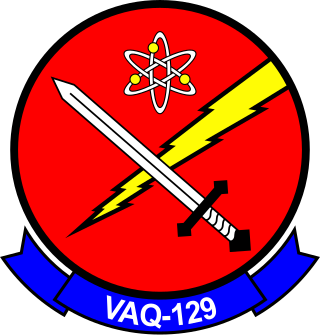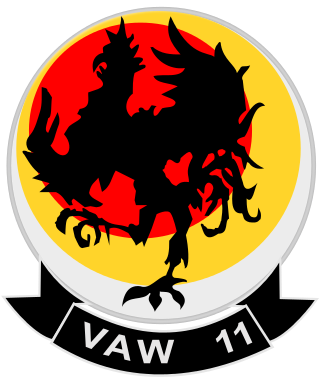
The Northrop GrummanEA-6B Prowler is a twin-engine, four-seat, mid-wing electronic-warfare aircraft derived from the A-6 Intruder airframe. The EA-6A was the initial electronic warfare version of the A-6 used by the United States Marine Corps and United States Navy; it was used during the Vietnam War. Development on the more advanced EA-6B began in 1966. An EA-6B aircrew consisted of one pilot and three Electronic Countermeasures Officers, though it was not uncommon for only two ECMOs to be used on missions. It was capable of carrying and firing anti-radiation missiles (ARMs), such as the AGM-88 HARM.

The Douglas A-3 Skywarrior is a jet-powered strategic bomber that was developed and produced by the Douglas Aircraft Company. It was designed by Douglas on behalf of the United States Navy, which sought a carrier-capable strategic bomber. In July 1949, Douglas was awarded the contract to produce its design, having bested eight other aircraft companies' submissions. Unlike rival designs, which had aimed for a 100,000 lb (45,000 kg) maximum take-off weight, the Skywarrior was developed for a 68,000 lb (31,000 kg) take-off weight, facilitating its use from the navy's existing Midway-class aircraft carriers. Large portions of the aircraft were produced by the Westinghouse Electric Corporation, including its early Westinghouse J40 turbojet engines, which failed to meet promises and were replaced by the rival Pratt & Whitney J57 engine by mid-1953. On 28 October 1952, the prototype XA3D-1 performed the type's maiden flight.

Electronic Attack Squadron 129 (VAQ-129) is the United States Navy's only EA-18G Growler training squadron. Known as the "Vikings", they are a Fleet Replacement Squadron, or FRS, and are charged with training all EA-18G aviators and developing standard operating procedures for the maintenance and operation of the aircraft. The squadron is permanently stationed at Naval Air Station Whidbey Island, in Puget Sound, Washington.
A naval flight officer (NFO) is a commissioned officer in the United States Navy or United States Marine Corps who specializes in airborne weapons and sensor systems. NFOs are not pilots (naval aviators), but they may perform many "co-pilot" or "mission specialist" functions, depending on the type of aircraft. Until 1966, their duties were performed by both commissioned officer and senior enlisted naval aviation observers (NAO).

{{Collapse/sandbox|

A carrier air wing is an operational naval aviation organization composed of several aircraft squadrons and detachments of various types of fixed-wing and rotary-wing aircraft. Organized, equipped and trained to conduct modern US Navy carrier air operations while embarked aboard aircraft carriers, the various squadrons in an air wing have different but complementary missions, and provide most of the striking power and electronic warfare capabilities of a carrier battle group (CVBG). While the CVBG term is still used by other nations, the CVBG in US parlance is now known as a carrier strike group (CSG).

Electromagnetic Attack Squadron 142 (VAQ-142), also known as "The Gray Wolves", is an EA-18G Growler squadron of the United States Navy stationed at Naval Air Station Whidbey Island, Oak Harbor, Washington. Their tailcode is AJ and their ATC callsign is "GRIM".
The Fleet Electronic Warfare Support Group's (FEWSG) mission as part of the US Navy was to provide electronic warfare simulation in a controlled environment during fleet exercises to help operators deal with EW threats, VAQ-33, VAQ-34 and VAQ-35 were the primary electronic aggressor squadrons to provide these fleet services flying the ERA-3B, EA-4F, EA-6A, EA-6B, EA-7L, EF-4B, EP-3J and NC-121K. FEWSG also operated their own aircraft under contract, most notably EB-47E, NKC-135A and an EC-24A. FEWSG was joined with the Fleet Deception Group Atlantic in May 1992 to form the Fleet Tactical Readiness Group (FTRG). The FTRG had an inventory of EW jammers and threat simulators for realistic training for operators.

Naval Air Station Key West, is a naval air station and military airport located on Boca Chica Key, four miles (6 km) east of the central business district of Key West, Florida, United States.

The Tactical Support Wing (TSW) is one of three reserve aircraft wings of the United States Navy. The wing reports to the Commander, Naval Air Force Reserve. It is headquartered at Naval Air Station Joint Reserve Base Fort Worth, Texas along with the reserve's Fleet Logistics Support Wing (FLSW). The third reserve wing is the Maritime Support Wing (MSW) which is headquartered at Naval Air Station North Island, California. The wing's primary mission is operational and training support for active forces. It is composed of five flying squadrons.

Electromagnetic Attack Squadron 139 (VAQ-139), also known as the "Cougars", is an EA-18G Growler squadron of the United States Navy. They specialize in electromagnetic attack and are currently stationed at Naval Air Station Whidbey Island, Washington. Part of Carrier Air Wing Seventeen, the Cougars deploy aboard the aircraft carrier USS Nimitz

Electronic Attack Squadron 209 (VAQ-209) is a United States Navy Reserve electromagnetic attack squadron. Known as the "Star Warriors", the squadron flies the EA-18G Growler carrier-based electronic warfare jet aircraft. It is assigned to the Tactical Support Wing and based at Naval Air Station Whidbey Island, Washington. Its mission is: "To safely train to attain and maintain mobilization readiness for immediate employment in event of war or national emergency."

Electromagnetic Attack Squadron 130 (VAQ-130), also known as the "Zappers", is an EA-18G Growler squadron of the United States Navy based aboard Naval Air Station Whidbey Island. Part of Carrier Air Wing 3, the Zappers deploy aboard the aircraft carrier USS Dwight D. Eisenhower. VAQ-130 is the oldest electromagnetic warfare squadron in the U.S. Navy.

Electromagnetic Attack Squadron 131 (VAQ-131), also known as the "Lancers," is a United States Navy tactical jet aircraft squadron specializing in kinetic and non-kinetic Suppression of Enemy Air Defenses (SEAD). They are based at Naval Air Station Whidbey Island, flying the EA-18G Growler. Their radio callsign is "Skybolt."

Electromagnetic Attack Squadron 132 (VAQ-132), the "Scorpions", is a United States Navy aircraft squadron based at Naval Air Station Whidbey Island, flying the EA-18G Growler. The squadron's radio callsign is "Scorp".
VAQ-35, nicknamed the Greywolves, was a short-lived Tactical Electronic Warfare Squadron of the United States Navy. The squadron was officially established by the Chief of Naval Operations on 14 August 1991, but had actually been operating since June. Most of its equipment and personnel came from the VAQ-142 Grim Watchdogs, a fleet EA-6B Prowler squadron which had stood down on 1 April. VAQ-35 joined VAQ-33 and VAQ-34, the other electronic aggressor squadrons of the Fleet Electronic Warfare Support Group in their mission of providing training for fleet radar operators in countering radar jamming and deception. The squadron also assisted with electronic warfare evaluations for research and development, and in developing electronic warfare tactics and countertactics.

VAQ-34, callsign Flashbacks, was a Tactical Electronic Warfare Squadron of the U.S. Navy. It was established on 1 March 1983 at the Pacific Missile Test Center, Point Mugu, California, under the Fleet Electronic Warfare Support Group. The squadron was formed to provide realistic training for ship crews to counter Soviet electronic and cruise-missile threats, and was modeled after its East Coast counterpart, VAQ-33.

Carrier Airborne Early Warning Squadron 11 (VAW-11), nicknamed the "Early Elevens", was an airborne early warning squadron, whose mission was to provide services to fleet forces and shore warning networks, under all weather conditions. The squadron was also responsible for combat air patrol and Anti-submarine warfare (ASW) missions. It was based at NAS North Island in San Diego, California, but had detachments serving aboard 13 attack carriers and antisubmarine carriers in the Pacific Fleet.




















